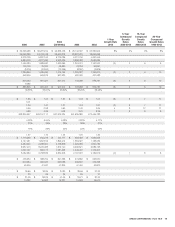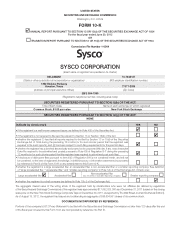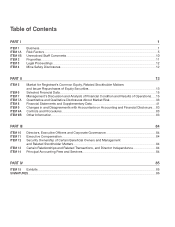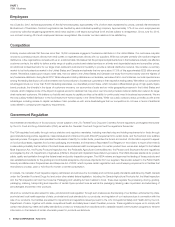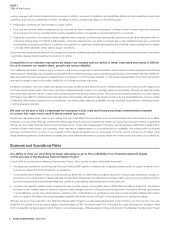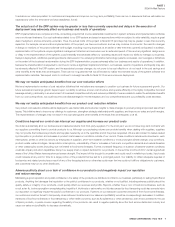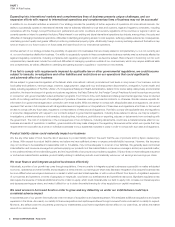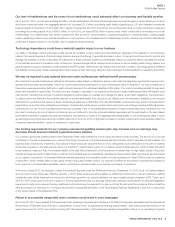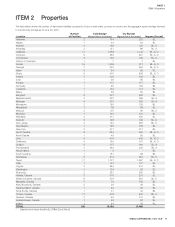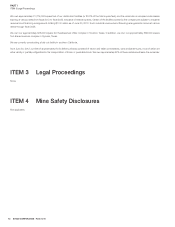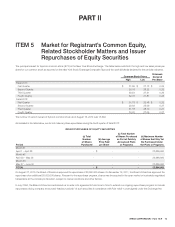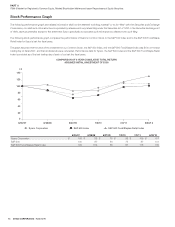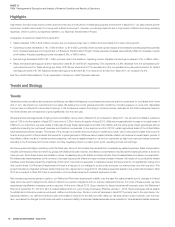Sysco 2012 Annual Report Download - page 30
Download and view the complete annual report
Please find page 30 of the 2012 Sysco annual report below. You can navigate through the pages in the report by either clicking on the pages listed below, or by using the keyword search tool below to find specific information within the annual report.SYSCO CORPORATION-Form10-K 7
PARTI
ITEM1ARisk Factors
to enhance our value proposition to customers and suppliers and improve our long-term profi tability, there can be no assurance that we will realize our
expectations within the time frame we have established, if at all.
The actual cost of the ERP system may be greater or less than currently expected and delays in the execution of
deployment may adversely affect our business and results of operations
ERP implementations are complex and time-consuming projects that involve substantial investments in system software and implementation activities
over a multi-year timeframe. Our cost estimates related to our ERP system are based on assumptions which are subject to wide variability, require a great
deal of judgment, and are inherently uncertain. Thus, the actual costs of the project in fi scal 2013(and beyond) may be greater or less than currently
expected. For example, as we continue implementation of the project, we have encountered, and we may continue to encounter, the need for changes
in design or revisions of the project calendar and budget, including incurring expenses at an earlier or later time than currently anticipated. In addition,
implementation of the systems require signifi cant management attention and resources over an extended period of time and any signifi cant design errors
or delay in the implementation of the systems could materially and adversely affect our operating results and impact our ability to manage our business.
Delays in deployment, additional operating problems discovered in the underlying information technology systems’ processes, cost overages or limitations
on the extent of the business transformation during the ERP implementation process adversely affect our business and results of operations. In addition,
because the implementation is expected to continue to involve a signifi cant capital commitment, our business, results of operations and liquidity may also
be adversely affected if the ERP system, and the associated process changes, do not prove to be cost effective or do not result in the cost savings and
other benefi ts at the levels that we anticipate. There can be no guarantee that we will be able to realize the intended results of the system software and
implementation activities. We expect costs to continue to outweigh benefi ts for fi scal 2013 as we commence deployment.
We may not realize anticipated benefi ts from our cost reduction efforts
We have implemented a number of cost reduction initiatives that we believe are necessary to position our business for future success and growth. Our
future success and earnings growth depend upon our ability to achieve a lower cost structure and operate effi ciently in the highly competitive food and
beverage industry, particularly in an environment of increased competitive activity and reduced profi tability. If we are unable to realize the anticipated benefi ts
from our cost cutting efforts, we could become cost disadvantaged in the marketplace, and our competitiveness and our profi tability could decrease.
We may not realize anticipated benefi ts from our product cost reduction initiative
Our product cost reduction initiative will be deployed to use market data and customer insights to make changes to product pricing and product assortment
issues. This initiative aims to improve our offerings to customers, strengthen strategic relationships with suppliers, and improve our sales and profi t margins.
The implementation of changes may not result in the cost savings and other benefi ts at the levels that we anticipate, or at all.
Conditions beyond our control can interrupt our supplies and increase our product costs
We obtain substantially all of our foodservice and related products from third-party suppliers. For the most part, we do not have long-term contracts with
our suppliers committing them to provide products to us. Although our purchasing volume can provide benefi ts when dealing with suppliers, suppliers
may not provide the foodservice products and supplies needed by us in the quantities and at the prices requested. We are also subject to delays caused
by interruption in production and increases in product costs based on conditions outside of our control. These conditions include work slowdowns, work
interruptions, strikes or other job actions by employees of suppliers, short-term weather conditions or more prolonged climate change, crop conditions,
product recalls, water shortages, transportation interruptions, unavailability of fuel or increases in fuel costs, competitive demands and natural disasters
or other catastrophic events (including, but not limited to food-borne illnesses). Further, increased frequency or duration of extreme weather conditions
could also impair production capabilities, disrupt our supply chain or impact demand for our products. In the summer months of 2012, certain agricultural
areas of the UnitedStates have experienced severe drought. The impact of this drought is uncertain and could result in volatile input costs. Input costs
could increase at any point in time for a large portion of the products that we sell for a prolonged period. Our inability to obtain adequate supplies of
foodservice and related products as a result of any of the foregoing factors or otherwise could mean that we could not fulfi ll our obligations to customers,
and customers may turn to other distributors.
Adverse publicity about us or lack of confi dence in our products could negatively impact our reputation
andreduceearnings
Maintaining a good reputation and public confi dence in the safety of the products we distribute is critical to our business, particularly to selling Sysco Brand
products. Anything that damages that reputation or the public’s confi dence in our products, whether or not justifi ed, including adverse publicity about the
quality, safety or integrity of our products, could quickly affect our revenues and profi ts. Reports, whether true or not, of food-borne illnesses, such as
e-coli, avian fl u, bovine spongiform encephalopathy, hepatitis A, trichinosis or salmonella, and injuries caused by food tampering could also severely injure
our reputation or negatively impact the public’s confi dence in our products. If patrons of our restaurant customers become ill from food-borne illnesses,
our customers could be forced to temporarily close restaurant locations and our sales and profi tability would be correspondingly decreased. In addition,
instances of food-borne illnesses or food tampering or other health concerns, such as fl u epidemics or other pandemics, even those unrelated to the use
of Sysco products, or public concern regarding the safety of our products, can result in negative publicity about the food service distribution industry and
cause our sales and profi tability to decrease dramatically.



